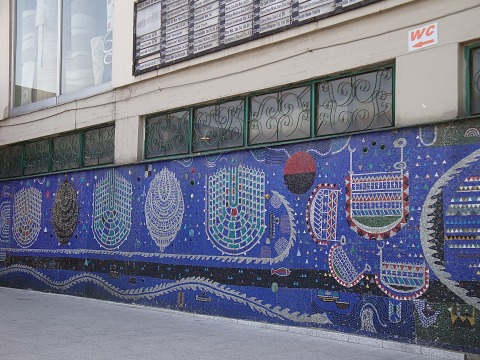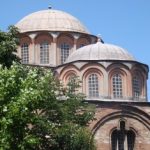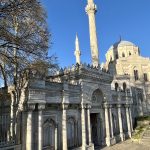Main road linking the Golden Horn and Fatih
Sliced through the old city during the French town planner Henri Prost’s redesign of it in the 1940s, Atatürk Bulvarı is a busy traffic thoroughfare that links the Atatürk Bridge across the Golden Horn at Unkapanı with the Fatih district passing right through the Roman-era Aqueduct of Valens.
Although the traffic is offputting, this is a part of the city which is home to several interesting historic monuments as well as several under-remarked public artworks. Its most important monument, though, is probably the Zeyrek Cami which began life as the Byzantine Church of the Pantocrator and has undergone extensive restoration.
From Atatürk Bridge to the Aqueduct of Valens (east side of street)
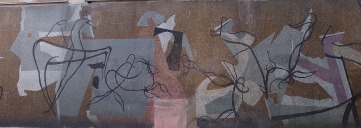 Nedim Günsür’s Atlar, 1967Of no great aesthetic interest, the 477-metre-long Atatürk Bridge across the Golden Horn opened in 1940. It is the fourth bridge to have provided a crossing from Unkapanı to Azapkapı. The first, the Hayratiye Koprüsü, was commissioned by Sultan Mahmud II in 1836.
Nedim Günsür’s Atlar, 1967Of no great aesthetic interest, the 477-metre-long Atatürk Bridge across the Golden Horn opened in 1940. It is the fourth bridge to have provided a crossing from Unkapanı to Azapkapı. The first, the Hayratiye Koprüsü, was commissioned by Sultan Mahmud II in 1836.
If you cross the messy road junction in front of the bridge Atatürk Bulvarı heads straight uphill from it. On the lefthand side a quick detour down into the sunken area beside the main road that leads through to Küçükpazarı will bring you to a mosaic named Atlar (Horses) by Nedim Günsür (1924-94) that rarely merits a mention but is one of a set of artworks commissioned from important artisis to adorn the İstanbul Manifaturacılar Çarşısı (İMC) at a time when it was thought that workers deserved to have access to art.
Walking uphill you will pass the rest of the İMÇ, a succession of concrete blocks housing commercial premises, many of them dealing with either music or upholstering fabric. When you reach the Third Block it’s worth diverting past the grave of İstanbul’s first mayor, Hızır Bey (1453-58), and walking out the other side where you will find, behind a wall, the Church of St Mary, better known to İstanbullus as the Ayın Biri Kilisesi (First of the Month Church) because it’s only open to the public on the first day of each month. People flock here to petition the icons for good fortune and in particular for fertility. Rather than simply praying to the icons, some of them grouped around an ayazma (sacred spring) in the basement, visitors buy a dilek anahtarı (wishing key) which they rotate in gaps cut out of the glass protecting the images.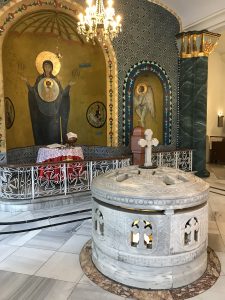
Shortly afterwards you will pass the Şebsafa Kadın (Zeyrek) Cami, built in 1787 with a sibyan mektebi (primary school) attached to it. Behind it there’s a fine view of the Süleymaniye Cami rising up on the city’s Third Hill.
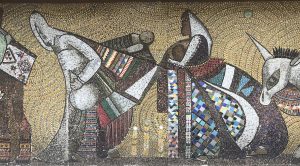 Two more vividly colourful mosaics lurk amid the unprepossessing İMÇ buildings. The first, designed by the poet-artist Bedri Rahmi Eyüboğlu (1911-73), defies its lack of a title to evoke the Bosphorus wending its languorous way past the mosques and palaces of the city on a sunny day. The second, by his Romanian-born wife Eren Eyüboğlu (1907-88), depicts the people of Anatolia riding donkeys and dressed in brilliantly colourful clothing.
Two more vividly colourful mosaics lurk amid the unprepossessing İMÇ buildings. The first, designed by the poet-artist Bedri Rahmi Eyüboğlu (1911-73), defies its lack of a title to evoke the Bosphorus wending its languorous way past the mosques and palaces of the city on a sunny day. The second, by his Romanian-born wife Eren Eyüboğlu (1907-88), depicts the people of Anatolia riding donkeys and dressed in brilliantly colourful clothing.
As you near the top of the hill the traffic is funnelled through a remarkable monument. The most conspicuous reminder of İstanbul’s complex ancient water-distribution system, the Aqueduct of Valens (Bozdoğan Kemeri) straddles Atatürk Bulvarı as it nears Fatih. Dating back to 375, the aqueduct, a double-tier of arches, still runs for almost a kilometre and would originally have been attached to a network of pipes that conveyed water from the Thracian forests beyond Edirnekapı, along the ridges of the Sixth, Fifth and Fourth Hills, then on to Beyazıt Meydanı. It continued in use right through until the 19th century which accounts for its astonishingly good state of preservation. It was restored in the 2020s.
If you walk under the aqueduct and turn left you will come to Şehzadebaşı and the great Şehzade Cami. If you turn right you will be able to walk up to the Fatih Cami. Continue straight ahead and you will come out near Aksaray tram stop.
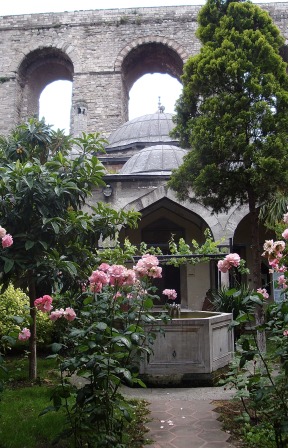 From the Aqueduct of Valens to the Atatürk Bridge (west side of street)
From the Aqueduct of Valens to the Atatürk Bridge (west side of street)
Starting back downhill towards the Golden Horn from the aqueduct you will come immediately to the many chimneyed Gazanfer Ağa Medresesi that once housed a museum of cartoons and humour. Sadly, since its restoration you can only peer through the gates at the locked medrese commissioned by the last Chief of the White Eunuchs to rule the roost in Topkapı Palace in 1599.
A side turning beside the medrese leads to a square surrounded by shops and restaurants that specialise in the produce and cuisine of the part of southeast Turkey around Siirt and Bitlis. Perhaps inevitably it is nicknamed Little Siirt (or the Kadınlar Pazarı) although officially it is Fatih Pazarı (Fatih Market). The odd half-hour or so spent browsing shops that major on different types of cheese and honey from the east as well as on curious doughnut-shaped loaves of bread that must be rehydrated before use will be a winner for anyone with the slightest interest in less familiar foods.
The square is centred on the Hüsambey Tezgarçilar Cami which is always very busy on Fridays. If you walk in front of this and continue downhill through the market parallel to Atatürk Bulvarı you will come to the Çinili Hamamı (Tiled Hamam, not to be confused with the one of the same name over in Üsküdar) that featured in Ferzan Özpetek‘s award-winning 1997 movie, Hamam. Designed by Sinan in 1546, it has been restored to serve as an upscale bath-house with a small museum (admission TL150) telling the story of the tiles that once covered the walls beside it. Also on display is a fine collection of nalins, the tall wooden clogs worn by women to the bath. On the back wall of the cistern beneath the museum can be seen graffiti of Ottoman ships.
Returning to Atatürk Bulvarı and continuing downhill you will see the curvy brick wall of the Byzantine Zeyrek Sarnıçı (Zeyrek Cistern). Unlike its fellows dotted about the city, this particular cistern was built overground. Although it has been restored it is yet to open to the public.
Immediately beyond the cistern are a group of government buildings housing the Sosyal Sigortalar Kurumu (Social Security Dept) that will certainly not appeal to everyone but are an award-winning example of the style of architecture known as Second National championed by architect Sedad Hakkı Eldem (1908-88). Inspect them closely and you may be able to recognise the way in which the overhanging roofs and other features reduce Ottoman stylistic traits to their simplest form. 
On the hillside above the main road looms the Zeyrek Cami that started life as the Church of the Pantocrator in the early 12th century. It boasts a magnificent location on a bluff overlooking the Golden Horn. However, until recently it stood in a very poor neighbourhood and was in an advanced state of dereliction. Restoration has made it possible for visitors to what is now a mosque to admire its Byzantine design although its magnificent opus sectile floor has been completely hidden beneath a carpet.
Eating
In “Little Siirt” the most unmissable menu items are buryan kebap, a pit-baked lamb kebab usually served on a bed of pide bread, and perde pilav, a risotto baked inside an inverted fez-shaped pot with shredded chicken, almonds and tiny currants. A great place to try them out is Sur Ocakbaşı (Tel: 0212-533 8088). Avoid Friday lunch times when every seat will have been taken by hungry worshippers from the local mosque.
Transport info
Many buses from Eminönü and Taksim pass up and down Atatürk Bulvarı although it’s also a pleasant walk through Tahtakale and Küçükpazarı if you get off the tram at Eminönü.
Nearby areas
